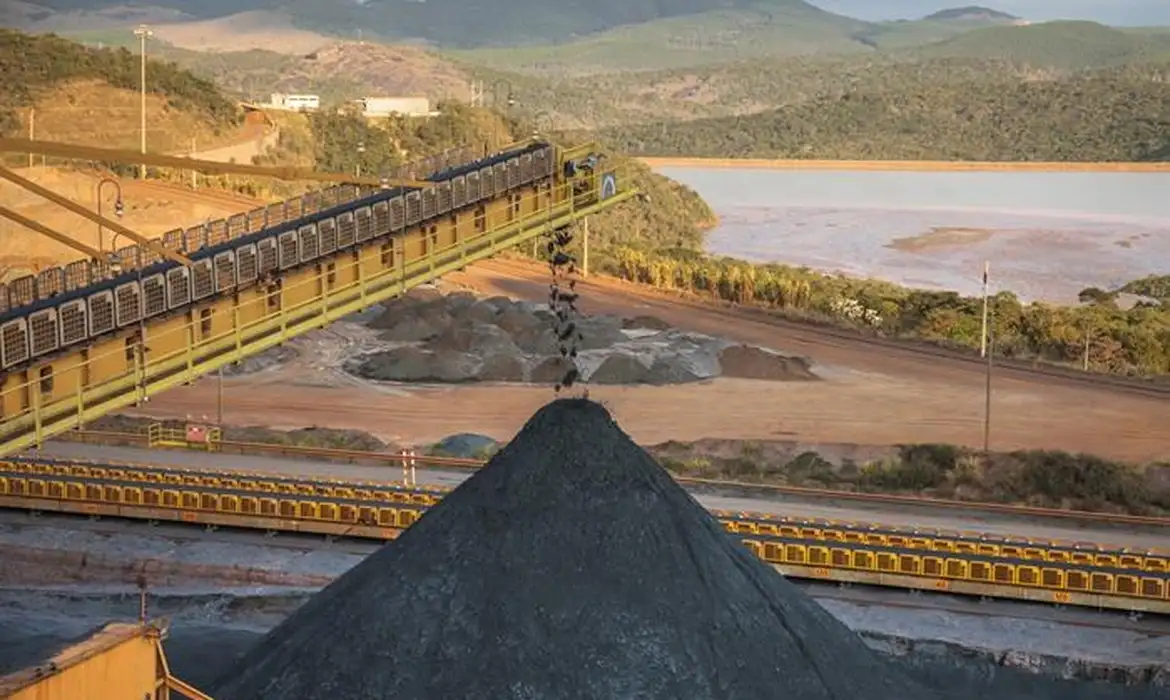By Pablo Pires Fernandes
Editor: Maurício Angelo
The tax evasion hole caused by mining companies in the compensation tax due in Brazil may have reached around R$35 billion in the last five years alone, according to CFEM collection data, in conservative estimates.
Surveys by the Brazilian Federation of Associations of State Tax Inspectors (Febrafite), the Federal Court of Accounts (TCU) and the Brazilian Office of the Comptroller General (CGU), cited in a technical note by the National Mining Agency (ANM), show that for every R$1 collected in CFEM (Financial Compensation for Mineral Exploration), R$1 is evaded.
The evasion follows the varied flow of tax collection, which follows the multibillion-dollar profits of the mining sector. In 2023 and 2022 the CFEM was around R$7 billion, 2021 was the peak, with R$10.2 billion, in 2020 it was R$6 billion and in 2019 R$4.5 billion. So, from 2019 to 2023, mining companies may have evaded around R$35 billion in CFEM.
But the scenario is even worse. Thousands of collection processes could lapse, with an additional shortfall of R$20 billion. In 2022, only 13,000 of Brazil’s 35,000 mining cases collected CFEM. In the same year, only 17 mining companies were inspected. The current CFEM team at the ANM has just four civil servants and a chief to oversee the tax throughout Brazil.
For Waldir Salvador, Institutional and Economic Relations consultant for the Association of Mining Municipalities of Brazil (AMIG), “CFEM evasion is a cultural issue, it’s indecent, it’s brutal”.
“Small mining companies don’t pay. Medium-sized companies complain that the country’s bureaucracy is too big, they start by evading and then pay what they think they should pay, which doesn’t make the business unviable. And the big ones do tax engineering and have a recurring practice of filing appeals saying they don’t agree with the way the ANM and the law impose it,” says Salvador.
CFEM was instituted by the 1988 Constitution and regulated in 1989, when Brazilian mining grew, as did international demand. More than 3,000 Brazilian municipalities receive CFEM, including both producing and affected cities. A further 2,000 municipalities receive it because they border the area. The tax therefore reaches almost the entire country.
For Salvador, “all the mining companies are fully aware that there is no inspection”. “And if there is no inspection, you don’t pay,” he says, reiterating that this procedure has already become a culture in the mining companies’ activity.
Photo: Portal Brasil / Ricardo Teles
The Mining Observatory does not accept advertisements from mining companies, lobbyists and politicians. Therefore, it needs readers to continue investigating what the mineral sector does not want society to know and to offer free access to the articles. Make a one-time or recurring donation on PayPal.
On the verge of collapse, ANM has had its demands partially met by the government
The successor to the National Department of Mineral Production (DNPM), the ANM is responsible for overseeing and monitoring all mining processes in the country.
According to Daniel Pollack, the ANM’s superintendent of Revenue Collection and Inspection, the number of civil servants is the lowest it has had since 1967, when the Mining Code was enacted: “Although there are 2,121 permanent civil servant positions, we have less than 700 working. This is approximately 42% less than the agency had in 2010, when it held the last general competition for all areas.”
On the other hand, during this period, Brazilian mining has made a huge quantitative leap, breaking profit records in recent years. Currently, there are more than 12,000 CFEM collection processes, with a potential statute of limitations that reaches the R$20 billion already mentioned. “We now have approximately R$1 trillion of calculation base that has not been inspected in the last 10 years, which is the statute of limitations,” says Pollack. “Over time, the capacity for analysis has been less than that of new processes, so today, with the current number of civil servants, without new processes, it would take 60 years to analyze all these liabilities.”
The TCU’s analysis found shortcomings in the area of information technology, high levels of tax evasion with the possibility of money laundering and inadequate distribution of the full amount of tax collected to the states and municipalities, among others.
“The curious thing is that while Brazilian mining has been growing, the agency has been shrinking at the same rate. Who cares? Only one side,” says Salvador.
The National Mining Agency (ANM) is going through its worst phase since its creation in 2017, with a lack of structure, budget, staff deficit, technological systems and inefficient databases. The precariousness and inability to monitor favors the evasion of CFEM and causes billions in losses to the public coffers.
The ANM’s technical note of May 2023 warned of the “real possibility of an imminent collapse in the ANM’s inspection, collection and distribution of revenue”. “This scenario gives us the figures we have today of only four employees on the team, in addition to the head to oversee the collection of CFEM from the more than 35,000 active mining processes across the country,” says Pollack.
Since its creation, the ANM has gained 17 new responsibilities, with an even greater workload, while demand in various sectors has only increased. Particularly fragile is the collection sector, in which there has been a two-thirds reduction in the organizational structure of the now defunct Directorate of Collection Procedures (DIPAR) of the then DNPM, either in commissioned positions or in the number of permanent civil servants over the last 13 years.
“The ANM submitted a call for tenders for 1,003 vacancies to the Ministry of Management and Innovation in Public Services (MGI) on May 9, 2023, but so far there has been no analysis by the MGI. Time is passing and the situation is becoming increasingly alarming,” says the civil servant. Salvador adds that “without structuring the ANM, it is impossible to put an end to tax evasion in Brazil”.
Pollack cites the example that, “of the 41 candidates approved and called in the 2006 and 2010 competitions for the position of Specialist in Mineral Resources, in the specialty of external auditing, who would have been assigned to the collection area, there was approximately 70% evasion without replacement, in addition to a significant number of retirements”.
The situation led to a 90-day strike by ANM employees in 2023. Although they haven’t been able to get a new competition approved so far, ANM employees reached an agreement with the Ministry of Mines and Energy and achieved salary equalization with other regulatory agencies, a long-standing demand, in a Provisional Measure published this month.
For Salvador, CFEM was born stillborn. “It was created with no budget, no staff and no structure. It’s a mockery,” he criticizes, adding that the Brazilian government has been silent for three decades and the current one is “playing at it”.
In a report, CGU pointed out various irregularities committed by the ANM, including “poor formalization and standardization of procedures for planning, executing, communicating and recording the results of inspections, as well as a lack of review and supervision at all stages of the work carried out”.

Accumulated lawsuits and legal liabilities
Bruno Milanez, a professor at the University of Juiz de Fora and a researcher with the interdisciplinary group Politics, Economics, Mining, Environment and Society (PoEMAS), says that one of the major problems with CFEM is that it is based on self-declaration. It is then up to the ANM to monitor both the volume of production reported and the CFEM paid. This obviously doesn’t happen due to the agency’s lack of structure.
“The mining companies take advantage of the lack of structure of the regulatory agencies to avoid paying. And they don’t pay. With this self-declaration of how much is produced, the price at which it was sold and the calculation of the amount, it has become this indecency of paying what you want and how you want,” Salvador criticizes.
In 2022, for example, only 17 mining companies were inspected in a sector that has thousands of companies. “How does the ANM cross-check the data and validate the data provided by the mining companies? Does the ANM take what is declared as the truth, or does it go through a fine mesh and cross-check data with the Internal Revenue Service? How does the ANM protect itself from tax evasion?” asks Milanez.
Today, the IRS believes that a legislative change is needed to grant access to the electronic notes of CFEM liabilities and the ANM’s database is precarious. Pollack notes that “unfortunately, with the lack of access to electronic invoices by the ANM, due to the reduced staff and inspection capacity, the ANM is unable to effectively combat the practice of evasion or underpayment of CFEM”.
Professor Ricardo Machado Ruiz, from the Center for Development and Regional Planning at UFMG’s School of Economic Sciences (Cedeplar), also highlights the lack of coordination between the Federal Revenue Service and the ANM when it comes to collecting CFEM. “Everyone evades. CFEM has to be collected by the ANM and it has to be paid, because it’s generating a lot of lawsuits and disputes that are storing up CFEM without passing it on to the municipalities, which don’t receive it”.
In his opinion, this is because there isn’t enough of a punitive fine to settle the tax disputes between the companies, the ANM and the Federal Government. “This creates an issue of CFEM not actually being paid.”
In addition to the ANM’s inadequate inspection team, there are six civil servants and one head of legal affairs. “At least 100 more staff would be needed to reduce liabilities and meet current demand, and more than 200 staff would be needed to satisfactorily meet the demand for inspections that are not being carried out,” says the ANM’s technical note.
Transfer to municipalities compromised
With the evasion of CFEM, the transfer to states and municipalities is compromised. In addition, the ANM’s system and database are outdated – they are done manually and without cross-referencing with the Bank of Brazil. This compromises the reliability of the amounts passed on.
By law (13.540/2017), CFEM funds are distributed as follows: 15% to the Federal District and the states where there is mineral production; 15% to municipalities and the Federal District when affected by the activity, even if production does not take place in their territories; 60% to the Federal District and municipalities where production takes place and 10% to the Federal Government. The regulation depends on a presidential decree, which could change the distribution of the amounts collected.
Last year, the ANM launched Call for Subsidies No. 3 to listen to civil society and gather input for CFEM regulations. The standard should be published this year. Meanwhile, the regulation of CFEM and its distribution to states and municipalities has caused debate in Congress, both in terms of the discretionary use of resources and as a basis for compensating for the losses in revenue caused by the Tax Reform.
Pollack explains that, since billions of reais are involved each year, “logically there are a number of interests in changing the tax rates, distribution rules and, eventually, changes that end up affecting the work of the ANM itself and the sector as a whole”.
Descubra mais sobre Observatório da Mineração
Assine para receber nossas notícias mais recentes por e-mail.





